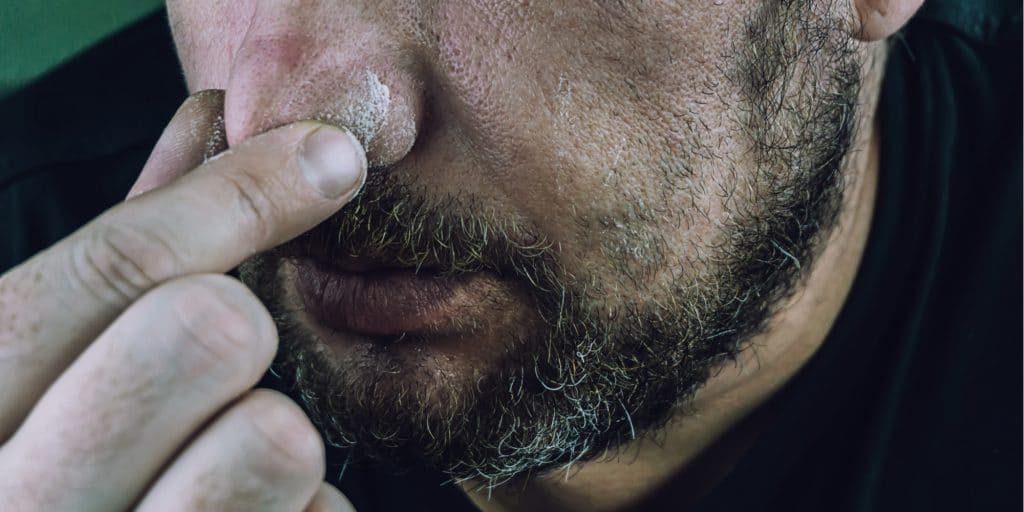 Due to the illegal nature of drug abuse, the slang that surrounds drug usage can be difficult to understand for those who aren’t familiar with it. Many people may be familiar with the term coke as a cocaine nickname, but what about “snow,” “toot,” or “white lady”? People who use drugs typically use slang terms as a way to avoid detection when talking about the effects of drugs. One of the common terms surrounding cocaine is coke nose, which refers to one of the symptoms of cocaine use: runny nose, congestion, and other nasal issues that occur when snorting cocaine.
Due to the illegal nature of drug abuse, the slang that surrounds drug usage can be difficult to understand for those who aren’t familiar with it. Many people may be familiar with the term coke as a cocaine nickname, but what about “snow,” “toot,” or “white lady”? People who use drugs typically use slang terms as a way to avoid detection when talking about the effects of drugs. One of the common terms surrounding cocaine is coke nose, which refers to one of the symptoms of cocaine use: runny nose, congestion, and other nasal issues that occur when snorting cocaine.
Table of Contents
What Causes Coke Nose?

Cocaine is one of the oldest and most popular street drugs available. According to the National Survey on Drug Use and Health, there are approximately 1.9 million cocaine users in America, with those between the ages of 18 and 25 being the most likely to actively use cocaine. Cocaine is most commonly sold as a fine white power, often laced with other things like talcum or baby powder.
The most common form of taking cocaine is by snorting it. Using cocaine causes your body to increase the levels of dopamine, a neurotransmitter responsible for feelings of motivation and pleasure, in the brain. This causes an intense burst of euphoria, which leads the cocaine user to ‘chase the high’ and dose repeatedly in order to maintain this feeling.
Over time, however, the brain adjusts for this behavior by increasing its tolerance for dopamine, and chronic cocaine users begin to lose the ability to feel pleasure or motivation normally due to their chemical dependence on the drug. They also receive less of an effect from the drug, and require larger and larger doses to feel the drug’s effects.
This habitual redosing behavior leads to individuals developing coke nose, as they begin to snort the drug more and more frequently to maintain its effects. Snorting cocaine (and the fillers mixed in with it) irritates and damages the mucous lining inside of the nose, causing coke nose. The most common symptoms of coke nose include nose pain, congestion, a constantly runny nose, nosebleeds, and a reduced ability to smell.
Signs of Cocaine Use
Similar to other addictive behaviors, snorting cocaine a single time is not the norm. Instead, individuals tend to engage in periods of frequent usage, snorting repeatedly and over long durations of time. For habitual cocaine users, the damage caused to the nasal passages far exceeds the a simple runny nose. Long-term cocaine abuse leads to nose problems for many, and people who have nasal symptoms are often clinically diagnosed with having “cocaine nose” or coke nose.
Coke nose is just one of the exterior symptoms of chronic cocaine use. In many cases, family members may recognize changes in an individual’s behavior consistent with drug use, such as coke nose, but may not know if the individual is snorting cocaine or other commonly snorted drugs, such as meth. When you know the signs of cocaine abuse, you can help your loved one to understand the harm of drug addiction and encourage them to seek treatment. Visible signs of cocaine use often include some of the following:
- Extreme mood swings: When an individual is under the effects of cocaine, they are usually very social, excitable, and full of energy, sometimes to the point of seeming irrational. This is called mania. When the effects of cocaine begin to wear off, however, the user’s mood changes. They may become withdrawn, sullen, and tired, and often cope with the sudden loss of energy by taking a depressant like alcohol to combat the residual effects of cocaine. In this way, cocaine abuse may mirror signs of bipolar disorder.
- Financial problems: The expense of maintaining a cocaine habit makes it difficult for chronic users to keep up with both their addiction and the normal financial needs of their lives. Additionally, the behavioral changes and impulsive decisions that come with addiction can make it difficult to maintain employment for long. As a result, many who struggle with cocaine abuse and addiction may turn to theft in order to pay for their habit, or repeatedly ask to borrow money from friends and family.
- Mental health symptoms: Chronic users can develop paranoia, anxiety, and depression, even when they’re not under the influence of the drug, as a result of the changes in their brain chemistry due to the long-term effects of cocaine. For this reason, not seeing physical signs like coke nose is not a guarantee that someone is not abusing cocaine.
- Cocaine withdrawal symptoms: Many of the withdrawal symptoms of cocaine use are psychological. These symptoms include irritability, insomnia and fatigue, depression, and impulsive cravings to get high. Because withdrawal symptoms can be overwhelming to the user, it’s advised that those who intend to quit using the drug do so at a licensed detox center as part of longer-term addiction treatment.
Long-Term Effects of Cocaine

Snorting cocaine causes coke nose, but it also causes damage to the circulatory system. Over time, cocaine abuse begins to affect the brain, lungs, heart, kidneys and gastrointestinal system. The extent to which long-term side effects become more severe increases over time. In some cases, long-term cocaine addiction can result in infertility, malnourishment, movement disorders, sexual dysfunction, numerous types of infections, and neurological problems.
While abuse often leads to addiction, they are not the same. Cocaine abuse often causes immediate negative consequences, but some people who abuse cocaine are capable of quitting on their own. Cocaine addiction is more complex. Due to cocaine’s highly addictive effects on the brain, users typically develop chemical dependency on cocaine rather quickly, and because of this, the process of detoxing from cocaine can be a scary thought for many who have developed an addiction to it.
Getting Help for Cocaine Addiction in Las Vegas, Nevada
Even when struggling with a cocaine addiction and coke nose symptoms, it can be difficult to accept that a substance abuse treatment program is necessary. But recognizing these symptoms in loved ones may be the first step towards getting them the help they desperately need.
A cocaine detoxification program, supervised by addiction professionals, can help ease the discomfort of withdrawal. At the Veteran’s Journey Recovery Center, our trained staff can help you begin on the path towards a healthier you with our drug detox program.
Continuing on to an inpatient substance abuse treatment program is strongly encouraged, as well as a thorough aftercare plan. Studies have shown that the best approach for helping those who are struggling with cocaine addiction to prevent relapse is a combination of detoxification and behavioral therapies, which helps to heal the body from the damage caused by long-term use of cocaine while also assisting patients with developing the mindset and motivation to take back control of their life from their cocaine addiction.
We are ready to help you develop the skills you need to achieve sobriety. Recovery takes work, but it starts with seeking help. Reach out to us today by phone at 888-828-2623 or fill out our confidential online form. Your path to sober living starts here.
The post Coke Nose and Other Signs of Cocaine Use appeared first on VJRC.
Source
Original Author: Veteran’s Journey Recovery Center

